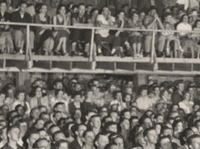This guest post from iPad Summit San Diego presenter, Rhoda Hahn (@mrshahn), first appeared on Daily Genius.
Long gone are the days of students reading textbooks, memorizing, and regurgitating information. Let 2015 be the year of increasing engagement and learning in your students. Giving students a real audience to showcase what they know can increase their sense of purpose, which can lead to a deeper understanding of what you want them to learn everyday in your class.
If you’ve given your students a “pretend” audience, try some of these easy ways to boost learning and give students a real audience:
- Publishing Work: Having a student publish their own work to the web empowers them to display their best work. I have noticed that when I ask my students to publish their projects to YouTube, they take more pride in their final product. You can also be their publisher! Currently, I have an iTunes U course (Under Our Feet) in early production where students are currently published. These students took the time to edit their work and to make sure that what they were explaining was understandable and clear. When I tell my students, “Hey, can I publish your work?” they light up and sometimes even redo their work because they have so much pride in what is about to be put on display for all to see!
- Tweet It out: Students want to be known and heard. Sometimes I look at students and say, “Hey! Can you tweet that so I can retweet you?!” You should see how excited they get! I don’t know what it is about Twitter that draws them in, but take advantage of this social media tool! For example, my 7th graders were studying what happens to M&Ms when placed in water. Several of them began taking time-lapse video with their iPads and iPhones. I asked one group to send me their video because I thought it looked so neat. I published this video to Youtube and then tweeted it out. They were so absolutely thrilled to be published and tweeted about that they lead the charge on the discussion of what was happening scientifically with the M&Ms. During discussion, I had 2 other students that sent me their videos and wanted to be tweeted about as well!
- Give them a real audience for their project: Find a project online to be a part of, find a classroom across the world to skype with, find someone in your community or school to get involved with what you are learning, or invite others to come into your classroom and learn with you! A few years ago my students began to use their biological understanding to make changes to our school campus. They came up with the “CHS Green Space,” which was a 5 year plan to help preserve an area of the campus outdoors that needed sustainability work. They researched present conditions of the land and created a detailed list of things that needed to happen within five years to achieve their goals of turning the space into a thriving ecosystem and outdoor learning space. The students had team representatives present their work to the district administration team and campus principal and were awarded grant funding to begin the project. Does that seem a little elaborate? Simply invite younger students into your classroom and have your students teach the younger students and watch understanding and engagement deepen.

An authentic learning audience can knock down the walls of the classroom and allow students to connect in ways that memorization will not allow. Students will no longer ask “Why do I HAVE to learn this?” and will instead begin to ask, “What can we do with this?” Students no longer have to wait until the real world hits to make an impact. They can impact their world and communities now in small and simple ways.
Rhoda Hahn will be presenting at the February 10-11 iPad Summit in San Diego. Registration is OPEN!

